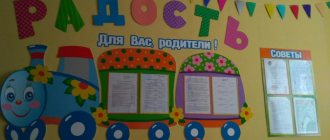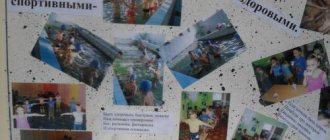Requirements for the corner of fine art activities in accordance with the Federal State Educational Standards of preschool education
REQUIREMENTS FOR THE CORNER OF ART ACTIVITIES IN ACCORDANCE WITH FSES DOO
Prepared by:
teacher of MBU D/S No. 139 “Oblachko”
Kuritsyna T.I.
Thematic zones in the group are a prerequisite for the harmonious all-round development of preschoolers. The richness of their content, together with suitable design, will allow children to gain a great experience during their stay in kindergarten. One of the favorite activities of both younger and older preschoolers is drawing, which contributes to the creative development of preschoolers. And the child will be able to find a suitable activity in the art corner, which the teacher will equip specifically for this purpose.
The purpose of this
corner of visual arts
is to develop children’s creative potential, develop interest in artistic activities, form aesthetic perception, imagination, artistic and creative abilities, independence, and activity.
Requirements for the creation and design of an art corner
According to the modern educational standard (FSES), the design of the fine art zone in a group must meet the following requirements.
- Compliance with sanitary and hygienic requirements.
The corner is located in a well-lit place (near the window). Furniture must be appropriate for the height of children
- Equipment meets the needs of this age
. After all, each age category is unique. For example, younger preschoolers are in the process of adaptation, so the teacher does not need to change the design often. Children's attention should not be distracted by unnecessary details. In addition, the art corner should contribute to the development of children's sensory skills. At an older age, conditions for self-expression are more important. Materials for creativity and aesthetic development (for example, picture albums) should be freely available to preschoolers so that they feel like “masters” in the group.
- High aesthetics
. A good corner attracts children's attention with its beautiful design. The guys should feel comfortable there and experience aesthetic pleasure. “Children’s” design is important - the inclusion of game characters (pictures and dolls) and creative works of students in the design.
- Multifunctionality.
The gaming environment can be modified depending on the learning situation and combined with other zones. After all, groups are not very large rooms, so every meter must be used rationally. Equipment and materials must be easily transformed to create a new game. For example, with the help of the Fine Arts corner, you can organize a role-playing game “In the artist’s workshop” (combined with the theatrical corner).
- Variability.
The equipment of the zone changes periodically: new material for creativity is added, children's demonstration works and design elements are updated. In addition, conditions should be created in the corner for individual (for example, drawing, coloring pictures) and collective activities (looking at albums, didactic games).
- Safety and high quality of materials
used in creating the zone.
This applies to both furniture and means for directly equipping the corner (for example, dangerous items should be stored in boxes with a lid). - Compliance with the gender principle.
As you know, boys and girls have their own preferences. The teacher should take this point into account when selecting material in the art corner (in particular, offer coloring pages with cars, airplanes, robots and princesses, flowers, butterflies, etc.)
Contents of the ISO corner in the group
The most important component of the art zone in a group is its capacity.
First of all, these are directly materials for creativity, both traditional and non-traditional
- Paper of various textures and formats (A3, A4, A5).
- Paper tinted in warm and cool tones, two-color (blue top of the sheet is the sky and green is the grass).
- Colored pencils, wax crayons, felt-tip pens, gel pens, markers, charcoal, sanguine.
- Gouache and watercolor paints, brushes of different thicknesses, palettes, sippy cups, brush stands.
- Small magnetic drawing boards.
- Natural material for decorating designs (cones, acorns, seeds, sawdust, etc.).
- Devices and tools for drawing in non-traditional techniques (foam rubber, cotton swabs, toothbrushes, stamps, cocktail straws, etc.).
- Coloring books of various subjects, stencils depicting animals, plants, fruits, vegetables, cars, etc.
- Aprons and sleeves for preschoolers.
When filling the corner with materials, the age of the students must be taken into account.
So, at a younger age, colored pencils and felt-tip pens of primary colors are enough: black, red, yellow, blue and green. Further, the color range expands as children grow older. New materials are added as they are mastered (for example, watercolors, sanguine and charcoal in the older group). The same applies to materials for non-traditional art techniques (for example, after students in the junior group have mastered drawing with cotton swabs in class, the teacher places them in the art area).
are also of great importance in the art corner .
That is, in the corner there should be
- Reproductions of paintings by famous artists, demonstrating various genres (landscape, portrait, still life), portraits of painters.
- Albums on decorative and applied arts (“Gzhel”, “Khokhloma”, “Haze”, etc.). If a given topic was discussed in class, additional material on it is provided.
- Samples of toys and handicrafts. For children of primary preschool age
– 2 – 3 types of folk toys (Bogorodsk toy, Semenov and other nesting dolls, Gorodets carved toy (horses), etc.).
For children of middle and senior preschool age,
3–4 types of works of folk art are selected (Dymkovo clay toy, works by Khokhloma and Gorodets masters, etc.). - Folder with the best children's works.
- Album with works in non-traditional visual techniques.
- Collections of beautiful cards on various topics: New Year, Eighth of March, Victory Day, Cosmonautics Day. Children can use them as samples to create drawings and posters.
- Step-by-step diagrams for drawing popular objects (a person in different poses, a cat, a dog, a horse and other animals, birds, flowers).
- Posters on the topic of visual arts.
An integral part of the fine arts corner are didactic games of this type.
.
For younger preschoolers, these are simple guides to reinforce primary colors. The child’s task is to determine which colors are used in each specific drawing. Games like “Decorate Matryoshka’s sundress” are also suitable for kids: you need to match the sundress and flowers by color
In the middle group, games of the previous age become more complex and it is already possible to introduce games for the development of compositional skills and games in decorative and applied arts. At first they are simple, for example, “Place the candies in the vases.” Children must outwardly learn to distinguish products from different crafts from each other (match candies and vases)
In older preschool age, these games become more complex. For example, in arts and crafts games, the goal is to deepen knowledge. Children are invited to use cards to recreate the sequence of performing elements of folk painting. The manual may be aimed at a more detailed study of a specific painting, for example, Khokhloma. In addition, games are added to consolidate knowledge about painting genres; about perspective, horizon line, distance and approach of objects, foreground and background of the picture.
Another important component (although not obligatory) of the art corner in the group is a stand for children’s work.
The child can hang his drawing there so that the teacher and other children can admire it.
An art corner organized in this way in a group will help preschoolers fully develop their artistic abilities, consolidate the material covered in class, and realize their own fantasies. The main thing is that materials and visual aids are always freely available. The bright and original design of this area is also important: after all, artistic taste needs to be developed from a very early age.
How to organize a corner for artistic and aesthetic development
“How to organize a corner for artistic and aesthetic development”
Consultation for preschool teachers
The modern system of preschool education tells us about the need to introduce new forms and methods of work. The implementation of the Federal State Educational Standard is aimed at psychological and pedagogical support for positive socialization and individualization, the development of children’s personality and the implementation of an individual approach to each child.
One of the most important factors in the artistic and aesthetic development of a child in a preschool educational institution is the subject-spatial developmental environment. It is important for the development of the child, for creating aesthetic, emotional and psychological comfort in the institution. According to the Federal State Educational Standard for preschool education, the artistic and aesthetic development of preschool children involves the development of the prerequisites for the value-semantic perception and understanding of works of art, the natural world, the perception of music, fiction, folklore, and the implementation of independent activities of children.
The subject-spatial environment, in this case, acts not only as a condition for the creative self-development of the child’s personality, but also as an indicator of the teacher’s professional creativity, since its formation requires the teacher’s imagination and various methods of creation.
Artistic and aesthetic education is implemented by different types of art and artistic and aesthetic activities. It is aimed at developing a child’s love for beauty, enriching his spiritual world, developing perception, figurative ideas, imagination, aesthetic feelings, aesthetic attitude to the surrounding reality, as well as introducing art as an integral part of spiritual and material culture, an aesthetic means formation and development of the child’s personality.
A developing subject-spatial environment provides the opportunity for communication and joint activities of children and adults; according to the Federal State Educational Standard, it must be content-rich, transformable, multifunctional, variable, accessible and safe.
For comprehensive development, various activity centers for children are used.
Theater corner: an important object of the subject-development environment, since it is theatrical activities that help to adapt, unite the group, and unite children with an interesting idea. The educational possibilities of theatrical activities are wide. By participating in it, children get acquainted with the world around them in all its diversity through images, colors, sounds; Speech develops and improves, the sound culture of speech and its intonation structure are activated, fulfilling its corresponding role, the child inevitably practices clear, clear expression. The theater center needs to include different objects.
Features of the design of the arts and crafts corner in kindergarten
Any creativity is a field for experimentation, self-expression and the formation of new skills in children. An interestingly designed fine arts corner will make children’s ideas come true and teach a lot.
Art corner in kindergarten
Drawing and modeling not only develop fine motor skills, stimulate imagination and imaginative thinking, but also teach you to compare the resulting result and the original, analyze the shape of objects and ways of conveying it. Creative activity forms in a child perseverance, determination, a desire to try something new, to express himself and show his vision of the world.
A striking example of how to properly design a fine arts corner in a kindergarten
Therefore, in the kindergarten group it is necessary to provide a place for artistic activities. A place where a child can independently engage in creativity should be characterized by the presence of all the necessary materials:
- coloring books;
- crayons;
- glue;
- paper;
- colored cardboard and markers.
- Examining reproductions of paintings by famous artists helps broaden children's horizons, consolidating knowledge about genres and styles of painting, techniques and methods of painting.
- Coloring pictures - this activity develops fine motor skills and imagination of the child.
- Reinforcing the material covered in the lesson - after familiarizing yourself with a particular drawing or sculpting technique (for example, appliqué with natural materials), a painting style (for example, Gzhel, etc.), it is recommended to invite children to draw another drawing in this painting style or create a picture in the studied technique.
- Didactic games - simple tasks for color knowledge in the younger group; games for developing compositional vision or knowledge of DPI styles - in the middle group. Games for memorizing painting genres and image techniques - in the older group.
- Be creative in your free time - sculpt, draw, create crafts using natural materials, or build origami.
Reproductions of paintings, folk crafts (painted nesting dolls, clay toys, trays and patterned wooden spoons) and small plastic sculptures will help expand your understanding of the beauty of the surrounding world.
It is also important to provide a stand in the group to display children’s drawings and plasticine figures.
Important! Praise encourages the child to continue creating and he becomes more confident.
Federal State Educational Standards requirements for creation and design in preschool educational institutions
According to the requirements of the educational standard, an activity corner must be provided in a well-lit place. Furniture and materials must be of high quality. The content of the corner should correspond to the age of preschool children, and creative materials must be changed from time to time or supplemented with new ones.
The most optimal furniture for a corner is a cabinet with open shelves on which you can place inspiring items (albums, reproductions of paintings), and isolate the materials necessary for creativity (paper, glue, scissors) from children and store them in a closed bedside table or drawers. Or it could be a table combined with a shelving unit.
For your information! For organized storage of all necessary materials (cardboard, paints, plasticine), you can use boxes of different colors or plain ones with bright symbols of the contents.
To maintain a creative mood, you can add an easel, on which it is useful to mount a painting by a famous artist for inspiration or the best work done by the children.
For storing pencils, brushes, as well as natural (cones, shells, grain, etc.) and waste (buttons, sequins, beads, etc.) materials, plastic or tin glasses of the same size and bowls are suitable.
Drawing corner in kindergarten: DIY decoration
To attract the attention of children and inspire creativity, the art corner should be colorfully decorated, not forgetting the age of the children. In the younger group, it is not recommended to frequently change images, since at this age children are in the process of adaptation and any changes in the environment cause stress.
For your information! For children in the older group, it is important to support the initiative for creative self-expression - materials should always be available, and the teacher needs to create an atmosphere in which children consider themselves masters in the group.
To create a positive creative mood, you can draw or pin a picture on the wall - a fairy-tale castle from the land of creativity, a fairy-tale or cartoon character (little Raccoon, Pencil from Dunno, the cat Matroskin or Fixiki, etc.) with a palette, brush or pencil. The picture can also be changed, for example, after completing a topic or becoming familiar with new material or technique.
Pencil holders in the corner Fine art
An option for dotted design of a corner is possible - blots or silhouettes of children's hands pasted in different places, a rainbow due to clouds or drops of rain, a bright, catchy inscription, place paper holders in the shape of an animal on the shelves, a stand for brushes in the shape of a truck, pencils or glasses with funny faces.
Thinking up a name for a corner with children
You can introduce children to a new space in a group and involve them in the creative process by jointly coming up with a name for the corner.
To begin with, it is recommended to suggest possible options: “Lukomorye”, “Country of Masters”, “Artist’s Corner” or “City of Colors”, then discuss the names proposed by the children and choose the best one by voting.
Main activities in the Fine Arts corner
The drawing corner involves the following activities:
Analysis of the design and operation of the art corner
In kindergartens, competitions are often held for the best design of the art corner.
An example of furniture arrangement in the fine arts corner
However, any teacher can analyze the pictorial corner in the kindergarten - you just need to answer the following questions:
An art corner organized in a group in a kindergarten helps develop a child’s creative abilities, instill artistic taste and teach children to independently look for ways to depict their fantasies.
Editor: Elizaveta Sergeevna Koneva
Primary school teacher of the first qualification category, defectologist.
Most preschoolers love to draw. They really like art classes in kindergarten, and therefore, in their free time, the children are happy to repeat their drawings and crafts. Many people like to color ready-made pictures, for example, on a certain theme (for girls - fairy-tale princesses, and for boys - cars, planes, etc.). Some people are interested in looking at albums with reproductions of paintings and elegant folk crafts (matryoshka dolls, wooden spoons, dishes, trays).
Many children in kindergarten enjoy coloring pictures in their free time.
All of these types of activities contribute to the creative development of preschoolers, and the child will be able to find a suitable activity in the art corner, which the teacher will equip specifically for this purpose. Children get the opportunity to reveal their potential and enrich their understanding of the beauty of the world around them.
In early preschool age, the art zone can be combined with a sensory corner
For the art activity center (as well as for other zones in the group), the teacher draws up a passport, which indicates its name, purpose and details the equipment of the corner.
Photo gallery: materials for fine arts
Video: materials and equipment for organizing art activities in preschool educational institutions (connection between drawing and sensory skills)
Visual materials are also of great importance in the art corner.
- Reproductions of paintings by famous artists, demonstrating various genres (landscape, portrait, still life), portraits of painters.
- Samples of toys and folk crafts (Zhostovo trays, Khokhloma spoons, Dymkovo and Filimonov toys, Gzhel cups, etc.).
- Folder with the best children's works.
- Album with works in non-traditional visual techniques.
- Collections of beautiful cards on various topics: New Year, Eighth of March, Victory Day, Cosmonautics Day. Children can use them as samples to create drawings and posters.
Photo gallery: visual material in the art corner
Games like “Decorate Matryoshka’s sundress” are also suitable for kids: you need to match the sundress and flowers by color.
In the middle group it is already possible to introduce games on arts and crafts. At first they are simple, for example, “Place the candies in the vases.” Children must outwardly learn to distinguish products from different crafts from each other.
The manual may be aimed at a more detailed study of a specific painting, for example, Khokhloma.
It is better to put decorative things on open shelves, and place creative materials in the nightstand
As an option, you can use a chest of drawers with drawers and a shelf at the top for the creativity area.
Table-rack - a convenient and compact option for kindergarten
If there is not a lot of space in the group, then a miniature corner shelving unit will help out.
An ordinary bookcase and hanging shelves can also help out.
Children can draw not only on the table, but also on a special easel
Another important component (although not obligatory) of the art corner in the group is a stand for children’s work. The child can hang his drawing there so that the teacher and other children can admire it. You can make such a thing with your own hands - from an ordinary mosquito net for windows. Decorative buttons are inserted onto the sides and colored laces are pulled over them. The designs are secured to the laces with small clips.
By showing imagination, any teacher can easily make a stand for children's work




